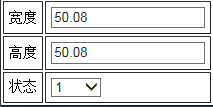C#基础系列——Attribute特性使用
前言:上篇C#基础系列——反射笔记总结了下反射得基础用法,这章我们来看看C#的另一个基础技术——特性。
1、什么是特性:就博主的理解,特性就是在类的类名称、属性、方法等上面加一个标记,使这些类、属性、方法等具有某些统一的特征,从而达到某些特殊的需要。比如:方法的异常捕捉,你是否还在某些可能出现异常的地方(例如数据库的操作、文件的操作等)经常使用try...catch。这个时候如果使用特性,就可以大大减少方法里面的try...catch的使用。你只需要定义一个专门捕捉异常的特性类ExceptionExAttribute,然后给这个特性类做些特殊处理,比如给它增加一个AOP拦截的功能(AOP拦截的方式很多,有兴趣可以搜搜看,园子里面很多类似的文章)。那么在可能出现异常的方法名称上面加上一个[ExceptionEx]特性标签,这个方法就具有自动捕捉异常的能力。还是加上官方定义:
特性提供功能强大的方法,用以将元数据或声明信息与代码(程序集、类型、方法、属性等)相关联。 特性与程序实体关联后,即可在运行时使用名为“反射”的技术查询特性。
特性具有以下属性:
-
特性可向程序中添加元数据。 元数据是有关在程序中定义的类型的信息。 所有的 .NET 程序集都包含指定的一组元数据,这些元数据描述在程序集中定义的类型和类型成员。 可以添加自定义特性,以指定所需的任何附加信息。
-
可以将一个或多个特性应用到整个程序集、模块或较小的程序元素(如类和属性)。
-
特性可以与方法和属性相同的方式接受参数。
-
程序可以使用反射检查自己的元数据或其他程序内的元数据。
(以上来自MSDN)
2、为什么需要特性:这个上面已经简单介绍过,特性能大大减少统一需求的代码量。其他不说,至少它能让我们的代码看上去更大气点吧~~
3、特性的使用:博主这次还是打算从三个方便分别介绍下特性的常规使用方法。当然这几种方式都是博主原来用过的,可能不是最好的举例场景,但是也算比较典型的特性用法吧。
(1)类的属性上面特性的用法:
之所以将这个放在最前面介绍是因为博主最近做的一个BS项目正好用到,并且使用场景也比较典型。首先介绍下使用场景:最近项目有一个需求,BS界面需要一个拖拽的功能。如下图

当将左边的3个div拖到右边来时,每个div都有自己的特有属性,比如2部门拖过来时,要显示如下属性:

1和3部门拖过来时可能对应的属性不同。
设计思路:每个div对应的Model,每个Model里面有自己特有的属性,然后属性上面加上特性显示属性的名称和默认值,以及界面应该呈现的html标签。
实现代码:
首先来看自定义的一个特性类:
public class DetailAttribute : Attribute { public string AttrName { set; get; } public string Html { set; get; } public string DefaultValue { set; get; } public string DataSource { set; get; } }
对应的Model:
public class Factory { [Detail(AttrName="宽度", Html="<input type='text' />", DefaultValue="50", DataSource=null)] public string Width { set; get; } [Detail(AttrName = "高度", Html = "<input type='text' />", DefaultValue = "50", DataSource = null)] public string Height { set; get; } [Detail(AttrName = "状态", Html = "<select></select>", DefaultValue = null, DataSource = "select text,value from status")] public string Status { set; get; } [Detail(AttrName = "Tag值", Html = "<input type='text' />", DefaultValue = "", DataSource = null)] public string Tag { set; get; } } public class FactoryDetail { [Detail(AttrName = "宽度", Html = "<input type='text' />", DefaultValue = "50", DataSource = null)] public string Width { set; get; } [Detail(AttrName = "高度", Html = "<input type='text' />", DefaultValue = "50", DataSource = null)] public string Height { set; get; } [Detail(AttrName = "状态", Html = "<select></select>", DefaultValue = null, DataSource = "select text,value from status")] public string Status { set; get; } [Detail(AttrName = "Tag值", Html = "<input type='text' />", DefaultValue = "", DataSource = null)] public string Tag { set; get; } [Detail(AttrName = "描述", Html = "<input type='text' />", DefaultValue = "", DataSource = null)] public string Desc { set; get; } }
然后在界面的拖放事件结束时通过js发送ajax请求来得到界面要呈现的html:
$(".jq-draggable-outcontainer").draggable({ helper: "clone", scroll: true, drag: function (event, ui) { // debugger; } }); $("#content").droppable({ drop: function (event, ui) { // debugger; if (ui.draggable[0].className.indexOf("jq-draggable-outcontainer") > 0) { var text = ui.draggable[0].innerText.trim(); $(this).append('<div class="window jq-draggable-incontainer" onclick="GetPropertiesByType(/'1/',this)" style="position:absolute;left:' +(event.clientX-20) + 'px;top:' + (event.clientY-20) + 'px" id="window' + iIndex + '"><strong>' + text + '</strong></div>'); $("#content2").html(""); cur_selector = $("#window"+iIndex); $.Ewin.AjaxPost("/Home/GetModelByType", { strType: "Factory" }, function (data, status) { var element = $.parseJSON(data.Json); var arrProp = element.element.property; //0.构造html var strHtml = "<div style='float:right;padding-top:0px;width:300px;height:auto;'><table cellpadding='5' border='1'>"; //1.拼html构造属性 strHtml += "</table></div>"; $("#content2").append(strHtml); }, function () { }, null); iIndex++; } } }); 对应的C#方法:
public JsonResult GetModelByType(string strType) {
//strType传过来的是Factory或者FactoryDetail var assembly = Assembly.Load("Ewin.Client.Web");//参数为程序集的名称 var oType = assembly.GetType("Ewin.Client.Web.Controllers." + strType);
//得到类的所有属性 var lstProperties = oType.GetProperties(); foreach (var oProperty in lstProperties) {
//得到每一个属性的特性类集合 IList<CustomAttributeData> lstAttr = oProperty.GetCustomAttributesData(); foreach (var oAttr in lstAttr) {
//得到每一个特性类的全称 Console.WriteLine("特性类的名称" + oAttr.AttributeType.FullName); Console.WriteLine("特性类成员如下:");
//得到特性类的所有参数 var lstAttrArgu = oAttr.NamedArguments; foreach (var oAttrAru in lstAttrArgu) {
//取每个特性类参数的键值对 Console.WriteLine(oAttrAru.MemberName + "=" + oAttrAru.TypedValue.Value); } //Console.WriteLine(oAttr.AttributeType+"——"+oAttr.NamedArguments); } } return Json(new { }, JsonRequestBehavior.AllowGet); }
GetModelByType方法结果简单构造下然后将属性的键值对返回给js方法,然后再由js追加到界面上面。这样通过特性和反射的结合能很快完成这个小功能的设计。
(2)类的方法上面特性的用法:
这个用法.Net framework里面就很多,如果MVC里面Filter过滤器的用法:

public class SuperLogStat : ActionFilterAttribute { //模块名称 private EnumModuleName moduleEnum = EnumModuleName.ModuleOther; //功能名称 private string functionName = string.Empty; //用户Id private string userId = string.Empty; public string Version { get { return ConfigurationManager.AppSettings["UploatStatVersion"]; } } public EnumModuleName ModuleEnum { get { return this.moduleEnum; } set { this.moduleEnum = value; } } public string FunctionName { get { return this.functionName; } set { this.functionName = value; } } //这两个方法都是父类的virtual方法,一个再return View()之前执行,一个再之后执行 // // 摘要: // 在执行操作方法之前由 MVC 框架调用。 // // 参数: // filterContext: // 筛选器上下文。 public override void OnActionExecuting(ActionExecutingContext filterContext) { try { string userName = filterContext.HttpContext.User.Identity.Name; this.userId = userName.Replace("china//", ""); } catch (Exception) { this.userId = string.Empty; } } // // 摘要: // 在执行操作结果之前由 MVC 框架调用。 // // 参数: // filterContext: // 筛选器上下文。 public override void OnResultExecuting(ResultExecutingContext filterContext) { UserLogUtils.LogUserStatic(this.userId, this.Version, EnumUtils.getEnumDescByValue((int)this.moduleEnum, typeof(EnumModuleName)), this.functionName); } }View Code
在Controller里面方法上面加上特性:
//调用 [SuperLogStat(ModuleEnum = EnumModuleName.ModuleHome, FunctionName = "待审核")] public ActionResult MyApplyToAuditing() { return View(); }
这个ActionFilterAttribute这个特性用法里面就有异常的拦截机制,和前面说的自定义的异常拦截是相同的。
(3)类上面特性的用法:
类上面特性的用法其实.Net里面也很多。比如为了避免new一个对象而使用的MEF就是一个很有说服力的例子:
在定义个类实现一个接口时:
[Export("Impc_TB_Test", typeof(Ifc_TB_Test))] public class Impc_TB_Test : Ifc_TB_Test { ...... }
定义接口没有任何特殊:
public interface Ifc_TB_Test { ...... }
然后在使用时只需要加一个[Import]标签,这个变量就会在编译时自动new一个Impc_TB_Test变量:
[Import("Impc_TB_Test")] Ifc_TB_Test service { get; set; }
在使用service变量时,就可以直接把它当做一个Impc_TB_Test对象来使用。是不是很方便。
这几种常见用法都是博主用过的觉得比较好的场景,当然特性的用法肯定远不止如此,欢迎大侠们指正拍砖~~











![[HBLOG]公众号](http://www.liuhaihua.cn/img/qrcode_gzh.jpg)

